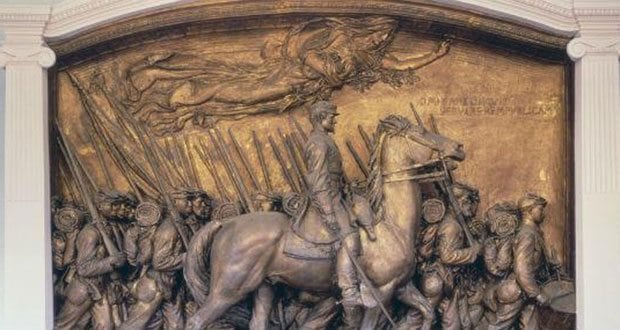
Situated on Boston’s Beacon Hill opposite the State House, the Shaw Memorial evokes a moving combination of intimacy of subject and grandeur of design. The life-size figures emerging from the surface of the relief commemorate the heroic contributions of one of the most outstanding military units of the Civil War.
Although it bears the name of its white leader, Col. Robert Gould Shaw, the monument bears equal witness to the black soldiers who served under him in the 54th Massachusetts (Colored) Volunteer Infantry Regiment. The effect produced is of a large body of men on the march, their numbers extending far beyond the left edge of the relief. The line of advancing soldiers was inspired by an actual event, the grand public sendoff of the unit as it marched to war from this very spot on May 28, 1863.
The initial impulse to formally honor the regiment came in 1865 from one of its veterans, Joshua Benton Smith, who proposed that a fitting memorial be set up in his commander’s hometown of Boston. Smith had worked for the Shaws during Robert’s childhood. He desired to “commemorate the great event, wherein he [Shaw] was a leader, by which the title of colored men as citizen-soldiers was fixed beyond recall.”
In his conception of the project, the emphasis was as much on the role of blacks in the fortune of their country as it was on their white leader.
The undertaking languished for nearly 20 years before the sculptor Augustus Saint-Gaudens was commissioned to produce the monument. The artist was well-known for his striking blend of naturalism of detail and ideal conception of subject. To enhance his portrayal of the soldiers, Saint-Gaudens hired black laboring men near his studio in New York to pose as models. Sixteen of the 23 faces in the relief are based on these studies.
On the one hand, the memorial is a disarmingly vivid representation of the martial cadence of war, while on the other it pays homage to the individuals who sacrificed their lives for a supreme cause. A female allegory of victory flying watchfully overhead elevates the mood of the relief to one of reverent, timeless contemplation. She holds an olive branch — the symbol of peace — and poppies, signifying sleep, death and remembrance.
Even when the relief was cast in bronze and officially dedicated in 1897, the sculptor’s attachment to the project continued. The work illustrated here is actually a slightly later version in colored plaster, produced in 1900 and displayed to great acclaim at the Paris Universal Exposition the same year.
Only the Latin inscription, Omnia relinquit servare rempublicam (“He gave up everything to serve the public good”), appears on the front of the memorial. The back of the stone arch framing the relief originally bore the names of the other white officers who had died with Shaw at Fort Wagner. Only in 1982 were the names of the black soldiers who also fell with them added to theirs.
The monument has served as a touchstone for the state of race matters from the outset. Saint-Gaudens himself was greatly moved by the sight of the veterans of the 54th as they passed by on parade during the inauguration ceremonies. Addressing the crowd, the notable scholar and Harvard professor William James extolled the vivid representation of the black soldiers in the relief: “There on foot go the dark outcasts, so true to nature that one can almost hear them breathing as they march.”
Yet the solemn dedication of the monument took place just a year after the Supreme Court’s 1896 Plessy v. Ferguson decision, which affirmed the manifestly unfair doctrine of separate but equal. Other observers of the new monument looked past its idealism to remark that the work of the soldiers commemorated there had only just begun.
The Boston poet Robert Lowell, writing his “For the Union Dead” during the civil rights movement well over 60 years later, saw the work as a persistent call to account for the failure of the country to promote true equality for all of its citizens. To underscore his admonitory tone, Lowell changed the third person of the Latin inscription on the monument from the singular to the plural to serve as his opening epigram: “They gave up everything to serve the republic.”
The Root






